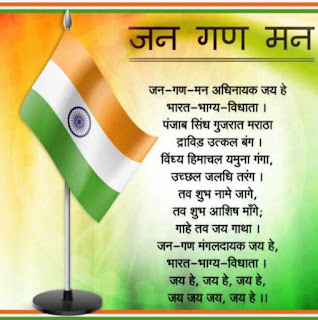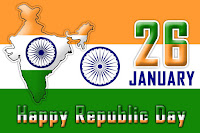Republic Day of India is a National day Celebrated on 26th January every year
Constitution of India Accepted on January 26, 1949, Effective in 1950
The Constitution of India came into force on January 26, 1950 and India became a Republic and that is why we celebrate January 26 as the Republic Day of the Country. The Constitution of India was adopted by the Union of Indian Parties on 26th November 1949 and came into force on 26 January 1950. From that day on, we became an Independent Republic. January 26 was chosen because on the same day in 1930, the Indian National Congress declared full Independence (Purna Swarajya).
 |
| Happy Republic Day-26th January |
Read Madam Bhikaiji Cama , 15thAugust Independence Day
 Event of Celebration
Event of Celebration
Just like we celebrate religious festivals with great joy and appreciation. Similarly, all Indians celebrate some National festivals. One of these National festivals is the annual 'Republic Day' which is celebrated on 26th January by our country, India. This day is celebrated by waving flags in schools, colleges, government and semi-government offices, societies and squares. The Tricolor flag is the National flag of the country. The flag is saluted at the hands of eminent persons, retired officers and leaders. Exercises from school to college. Speeches are made at various events. Children dance with flags in their hands. The National flag is proudly displayed.
Republic Day is also celebrated in private companies across the country. Trio Colour Flags are hoisted in the Government offices as well as Trio colours Lighting, car with tricolor balloons, flags, Rangoli etc. Some celebrate Republic Day at home People decorate Their home, while others celebrate it with social campaigns and events.
Republic Day is celebrated on the school grounds / campus ,Festive rallies are held, essay, oratory, painting competitions are organised. The chief guests come to the school / college premises to pay homage to the flag, many dignitaries attend the Republic Day events. The national anthem is sung after the flag salute, and everyone stands up for the national anthem and respects it. Guests, teachers give their speeches. Some schools organize patriotic cultural events.
Read National Law Day Information
The Government of India Celebrates Republic Day at Rajpath
The Government of India celebrates Republic Day at Rajpath in the Capital Delhi in front of the Hon'ble President of India. On this day, there is a grand parade on the highway that showcases Indian culture, heritage and defense potential. Hundreds of people visit Rajpath and enjoy this National Event. The Event is Broadcast on Television, various news channels and now a days on YouTube, Facebook. The President and the Prime Minister of India address the entire country.
Heads of Government of various countries are Invited as Guests for the Republic Day of India. For the year 2018, India is inviting heads of state or Government from 10 ASEAN Countries - Brunei, Cambodia, Indonesia, Laos, Malaysia, Myanmar, Philippines, Singapore, Thailand and Vietnam.
Every year on the eve of Republic Day, the President of India bestows Padma Awards to Indian citizens. After the Bharat Ratna, these are India's second highest civilian awards. In decreasing order of importance, these honors are granted in three categories: Padma Vibhushan, Padma Bhushan, and Padma Shri.
- Padma Vibhushan Award Padma Vibhushan For "distinguished and extraordinary service. The Padma Vibhushan is India's second highest civilian honour.
- Padma Bhushan Award Padma Bhushan For "distinguished service of a high order," Padma Bhushan was awarded. The Padma Bhushan is India's Third highest civilian honour.
- Padma Shri Award Padma Shri For "distinguished service. The Padma Shri is India's Fourth highest civilian honour.
The Constitution of India is the core of Republic Day
The Constitution lays out the foundation for our fundamental rights, as well as the structure, functions, powers, and duties of government institutions. It also establishes Indian citizens' fundamental rights, guiding principles, and responsibilities. According to the Constitution, India is a sovereign, socialist, secular, democratic republic, which strives for justice, equality, freedom and fraternity.
The Constitution also outlines our Fundamental rights and responsibilities. Our 6 basic rights include freedom, integration, secularism, culture, and the right to education, as well as constitutional remedies. The Constitution, the National Emblem of India, and the Constitution's core duties obligate all citizens to maintain India's legacy, preserve its composite culture, and aid in its protection. It requires all Indians to establish a sense of shared Fraternity, safeguard the environment, protect public property, develop a scientific temperament, and reduce violence.
 Significance of this Day
Significance of this Day
On August 15, 1947, India became Independent. The Leaders drafted a Constitution for the country to decide which social measures would be implemented, and what will be the future Goals of Independent India, which manner the country will go.
On August 28, 1947, a committee was set up under the Chairmanship of Dr.Babasaheb Ambedkar. On November 4, 1947, the committee presented the first draft to the Legislative Assembly. This was discussed and improved in several sessions in the Assembly for 2 years, 11 months and 18 days. These sessions were open to the public. On 24 January 1950, 308 members of the Legislative Assembly approved the draft and issued two manuscripts of the Constitution, one in Hindi and the other in English. Two days later, on January 26, 1950, the Constitution came into force and India became a Republic. The chairman of the draft committee, Dr. Ambedkar was hailed as the Architect of the Constitution of India.
 |
| Happy Republic Day |








2 Comments
This blog really helpfull to everyone and Essay on Republic Day in hindi
ReplyDeleteThank you !!!!!
Delete